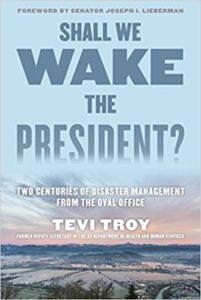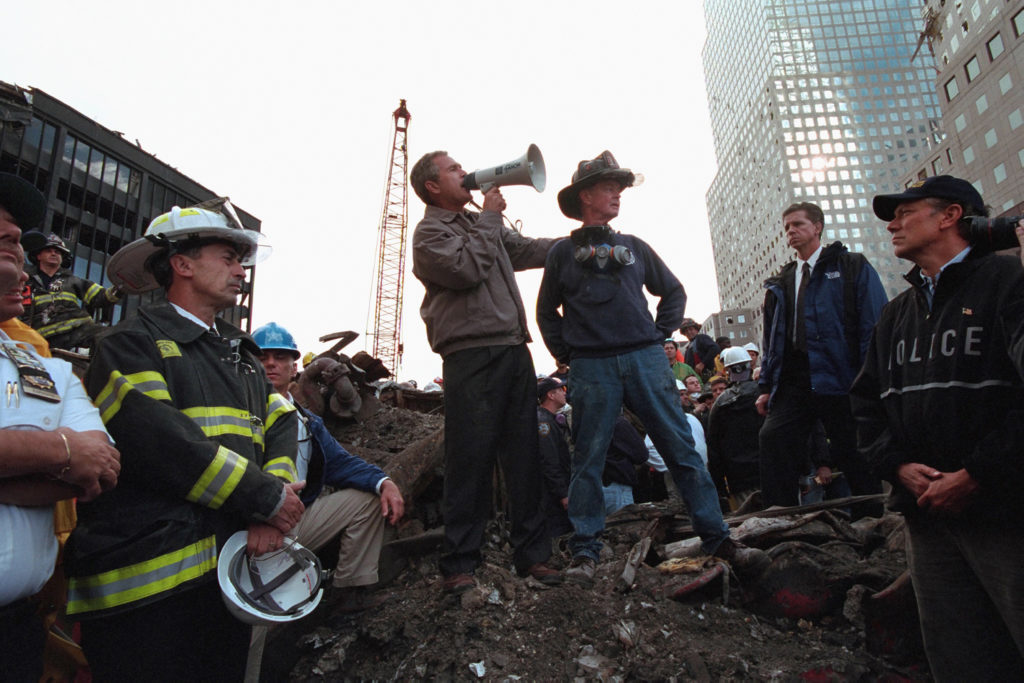Editor's Note (March 2020): We post this timely reminder that at the heart of our safety here at home are individual actions - don't wait; do the right thing. Three years ago, we wrote: "It’s on you. With the simple 'wash those hands,' 'be prepared to be on your own,' and even, occasionally, 'pray,' Troy fights the increasingly common American reflex to rely on the federal government."
 Shall We Wake the President, by former Deputy Secretary of Health and Human Services Tevi Troy, subtitles itself Two Centuries of Disaster Management. The title is a bit of a fraud. Yes, examples of presidential leadership or lack thereof are highlighted across the chapters. President Lyndon Johnson’s reaction to the Watts riots, President George W. Bush’s after al-Qaeda’s Sept. 11, 2001 attacks and Hurricane Katrina, President Ronald Reagan and the Tylenol tampering, and Franklin D. Roosevelt and the Great Depression. Herbert Hoover, Jimmy Carter, Benjamin Harrison (the Johnstown Flood), Grover Cleveland, Barack Obama, Gerald Ford, and more. They’re in there and Troy renders them human in success and failure.
Shall We Wake the President, by former Deputy Secretary of Health and Human Services Tevi Troy, subtitles itself Two Centuries of Disaster Management. The title is a bit of a fraud. Yes, examples of presidential leadership or lack thereof are highlighted across the chapters. President Lyndon Johnson’s reaction to the Watts riots, President George W. Bush’s after al-Qaeda’s Sept. 11, 2001 attacks and Hurricane Katrina, President Ronald Reagan and the Tylenol tampering, and Franklin D. Roosevelt and the Great Depression. Herbert Hoover, Jimmy Carter, Benjamin Harrison (the Johnstown Flood), Grover Cleveland, Barack Obama, Gerald Ford, and more. They’re in there and Troy renders them human in success and failure.
The disasters are there as well – name your nightmare and Troy makes it worse. The book is divided into Acts of God (pandemics, flood, weather, and economic collapse) and Acts of Man (terror, tainted food, bioterror, loss of the power grid, and civil unrest).
But at the end of the day, Shall We Wake the President is neither about presidents nor about disasters. It is about you.
And me. And us.
What do we expect from our presidents? What is his (or her) responsibility during a crisis and what is our responsibility? How much planning do we demand of the federal government, how much of the states, and how much are we willing to do ourselves? How long will we wait to be rescued before organizing our own rescue? Can we organize our own rescue if we don’t know our neighbors and if we don’t have a community to turn to?
Troy is a great storyteller. Bits of history you never learned in school are in the tales of earlier presidents, and things you’ve probably forgotten are in the later works. But interesting as the stories are, it is hard to escape the fact that each is a non-fiction horror story, some of which resulted in the deaths of thousands of our fellow citizens.
In each chapter, after describing its historical antecedent, Troy suggests steps people can take to protect themselves from the effects of the “next time.” There are lists of necessities to have at home – a diversified food supply, a medical kit, bottled water, and cash in case the electrical grid (and your ATM) goes down. (The idea that a couple hundred million of us should start kitchen gardens – just in case – is a little far-fetched, but it isn’t wrong.) There are suggestions for navigating a city during a riot – don’t try to stop illegal behavior, stay inconspicuous, and sometimes don’t run, just walk. The chapter on civil unrest urges strong locks on your doors, but also knowing your neighbors, their needs and their capabilities, as well as being part of church or synagogue groups and civic organizations.

It’s on you. With the simple “wash those hands,” “be prepared to be on your own,” and even, occasionally, “pray,” Troy fights the increasingly common American reflex to rely on the federal government.
Some of the most important parts of the book are explanations of the practical and theoretical limitations of the government. The 1878 Posse Comitatus Act prevents the president from sending in the National Guard without a request by a governor – see the chapter on Hurricane Katrina. States jealous of their prerogatives can make stockpiling drugs or emergency equipment difficult. Sometimes the crisis itself – such as a bioterror attack – unfolds only over time, making early intervention by the government unlikely. Sometimes the president doesn’t want to set a precedent pre-empting the obligations of states by providing federal aid. The creation of FEMA in 1979 almost instantly federalized storm damage management – which had previously been the purview of states.
In all cases, the American tendency to look to government for security and solutions is addressed. In the first chapter, “Pandemics,” we learn Woodrow Wilson refused to let the spread of Spanish Influenza halt or even change his plans to send Americans to Europe to fight in World War I. And, because the pandemic appears to have begun in a Kansas military base, the flu was sent to Europe with the troops. “Of the American soldiers who died in Europe, half died from the flu.” Not only did Wilson continue to send troops abroad, he declined to address the issue or take steps at home to prevent the spread of the disease. As many as 675,000 Americans died in the pandemics at home (as many as 50 million worldwide) – some number of them died because they didn’t take precautions that the government might have either urged or mandated.
President George W. Bush took the opposite approach after, according to Troy, having read John Barry’s account of the 1918 pandemic. Bush’s strategy for pandemic included investments in vaccines, antivirals, domestic preparedness and international cooperation. Key aspects of preparedness were rapid diagnosis, antimicrobial treatments, making the vaccine available, and giving public health officials the ability to quarantine carriers.
This President Bush also has the distinction of being on Troy’s list of best and worst presidents in a major crisis. He received high marks for 9/11, but dismal grades for Hurricane Katrina. For the first:
“He did not spread misinformation and was able to shape the… narrative of 9/11 into one of tragedy, but also heroism. He also effectively reached out to Congress, worked through his agencies… and empowered cabinet officials to take actions necessary to deal with the terror threat.”
On the other hand, after Hurricane Katrina:
“The governmental response was widely characterized as delayed and disorganized. Bush compounded the situation by flying over the affected area, and the disastrous photo of him surveying the damage from above made him seem callous and out of touch.”
Bush himself outlined four mistakes on his part in handling Katrina: Failure to urge an earlier evacuation; failure to return to Washington sooner; slowness in showing both sympathy and federal action; and waiting too long to call in federal troops.
But true to his pattern of separating federal requirements from state and local mandates, Troy notes the failures at those levels in delaying the evacuation of the city; delaying a decision to allow federal troops; lacking the means to communicate within the state and local government; and leaving “basic tasks typically assigned to state and local officials … to federal responders.”
The outline of effective presidential action starts to take shape – and the limits of it do as well. Presidents are best when they:
- Have plans,
- Appear to be in charge – even if their real control is limited,
- Communicate clearly and often,
- Provide direction, and
- Show up.
President Johnson’s vacation had an impact on his response to the Watts riots, and Hurricane Katrina occurred while President Bush was on vacation and many of his staff members were out of the country for a staff wedding. Troy notes, “President Obama seemed out of touch when he left to play golf after ISIS terrorists beheaded an American captive.” Obama was also criticized for attending a political fundraiser in Las Vegas two days after the Benghazi attack.
The body of the book concludes with the understanding that disaster response is on us:
“Individuals have a tough job … Although many Americans do know what to do in terms of crisis, millions more do not. If disaster strikes, we all will have to keep ourselves, our families, and our loved ones going – without staff, without a massive bureaucracy, without an army – with just ourselves. It is resilience, coupled with smart preparation that will get us there …”
At its very heart, the story of humankind is one of billions of individual actors trying to survive as best they can in an often difficult and dangerous world. Reading this book will make you better equipped to understand and to overcome whatever disaster the world might throw at us.
But don’t stop there. The appendices are well worth reading: “Presidential Lessons Learned,” a checklist for “When Presidents Should Get Involved,” and – a personal favorite – “The Five Best and Five Worst Presidents at Dealing with Disaster.” If the first two are reminders of the limitations of government, the last is worth the price of the book.
Shoshana Bryen is the editor of inFOCUS Quarterly and the Senior Director of the Jewish Policy Center.





